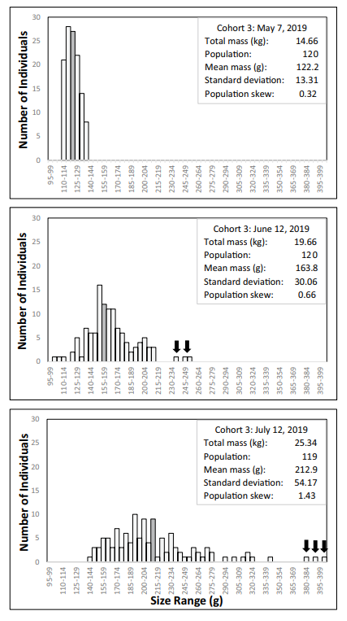POPULATION GROWTH DYNAMICS AND THEIR IMPLICATIONS FOR FISH WELFARE IN MIXED-SIZE COHORTS OF KOI GROWN IN A COMMERCIAL-SCALE AQUAPONICS SYSTEM
Information on growth dynamics of koi grown long-term in recirculating aquaculture systems (RAS) is lacking. The objective of this study was to establish baseline parameters for an older (i.e. not larval or juvenile) population of koi grown in a commercial RAS. A population of 1033 1.5-year-old koi (6 g to 764 g) cultured in a 60 m3 commercial decoupled aquaponics system with cannabis were graded into distinct size cohorts (six cohorts, from ‘very small’ to ‘very large’) and their growth and population distributions were monitored over 66 days. Fish were weighed at day 0, day 36 and day 66.
Feed conversion ratios and specific growth rates were between 2.8 – 4.1 and 0.63 – 0.87, respectively, and increased and decreased with fish size, respectively. Regardless of average initial weight or cohort size, several individuals in each tank vastly out-grew the rest of the population, resulting in right-skewed population distributions. Right-tail asymmetry (skewness) of the population distributions became more pronounced for all cohorts, except the largest cohort. Similarly, kurtosis (the relative number and extremity of outliers compared to a normal distribution) increased in all cohorts. These results suggest that the production of “tobi koi” or “shoot carp”, is not restricted to larval and juvenile koi populations, and that if size disparity cannot be eliminated through husbandry practices (e.g., minimizing feed competition), populations should be graded 2-3 times yearly to promote growth and welfare of the smallest fish in a cohort.
